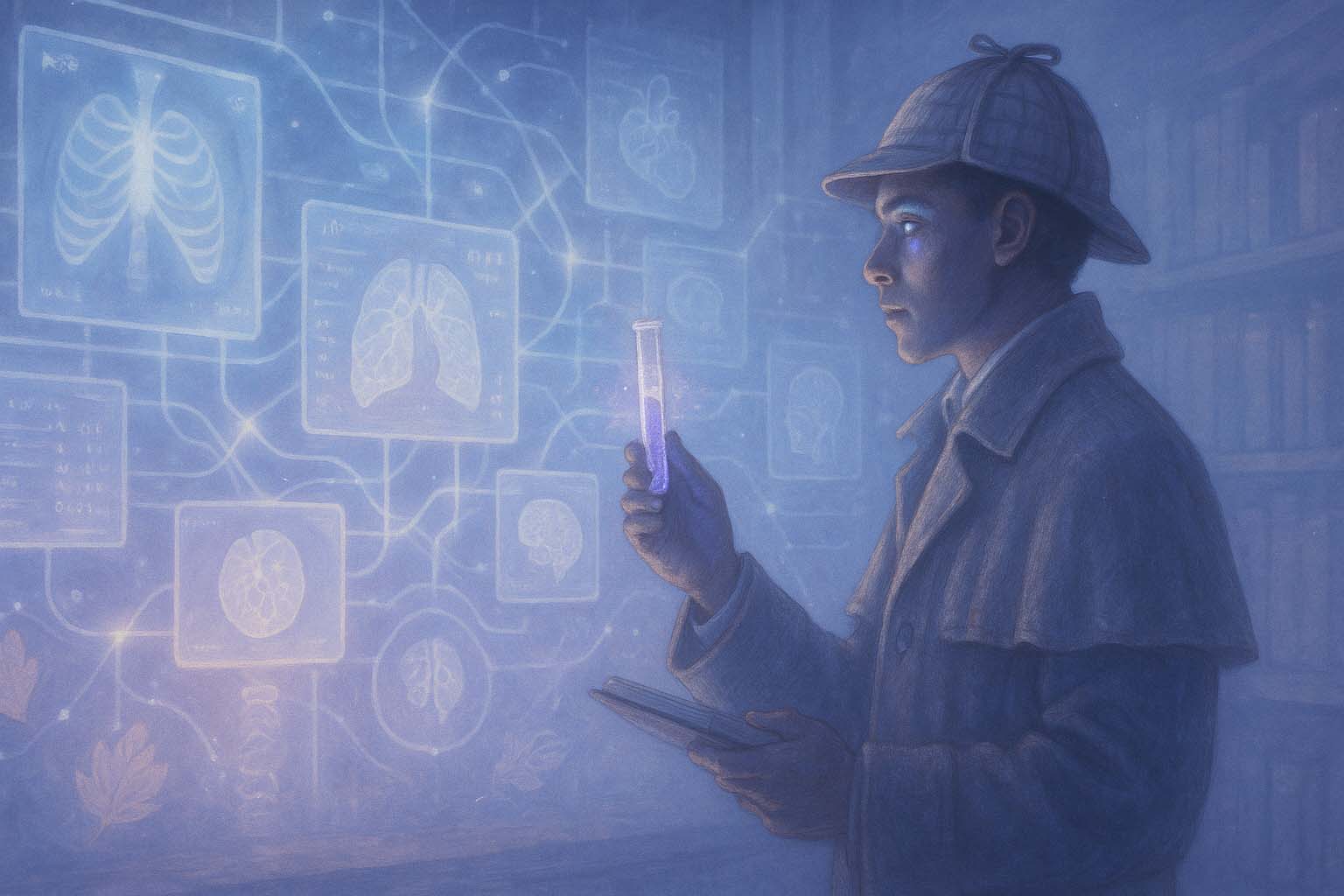
Medical Investigations
- Gathering Evidence
🧪 The Detective’s Guide to Medical Investigations
The history gave you the narrative.
The examination offered visible and tactile clues.
Now, it’s time to consult the forensics lab.
Welcome to the final phase of your initial investigation, where suspicion meets science. Just as a detective collects fingerprints, fibre samples, or DNA to support their theory, you now order medical investigations to confirm or refute your clinical hypotheses.
But be warned: tests are not truth. They are tools—powerful, but fallible. The best detectives don’t order every test available; they choose wisely, guided by story, signs, and a clear line of inquiry.
🧬 Blood Tests: The Biochemical Trail
Blood doesn’t lie—but it doesn’t always speak clearly either. A skilled clinician must interpret its messages with care.
🧰 The Basics (Every Detective’s Toolkit)
- Full Blood Count (FBC): Your first sweep of the crime scene. Is there anaemia? Infection? A suspicious rise in eosinophils?
- Urea & Electrolytes (U&Es): The body’s internal chemistry—how well are the kidneys managing the balance of fluids and salts?
- Liver Function Tests (LFTs): Detect liver stress, biliary obstruction, or damage—an elevated ALT might point to hepatitis; a high ALP might signal cholestasis.
- C-Reactive Protein (CRP)/ESR: Markers of inflammation. If the body is fighting a fire, these will tell you—but not where or why.
- Glucose/HbA1c: Metabolic status, uncovering the silent thief of diabetes.
These are your entry-point assays—the swabs and dustings of clinical sleuthing.
🔍 Specialised Tests (When the Plot Thickens)
- Cardiac Troponins: When chest pain makes you suspect a myocardial infarction, this test reveals heart muscle damage.
- D-dimer: A hazy witness—useful when ruling out clots, but prone to false alarms.
- TSH and T4: In a case of unexplained fatigue, weight gain, or anxiety, you might uncover a rogue thyroid.
- Autoimmune Panels: Searching for the body’s internal saboteurs—ANA, rheumatoid factor, anti-dsDNA.
- Toxicology Screens: When substances may be playing a hidden role in the story.
Always remember: a blood test is a snapshot, not a story. Interpret it in the context of the case file.
🩻 Imaging: Illuminating the Invisible
When the clues lie beneath the surface, the detective turns to imaging—your X-ray vision, your window into hidden worlds.
📷 X-Rays: The Basic Snapshot
Fast, accessible, and revealing.
- Chest X-ray: The faithful first responder—great for spotting pneumonias, heart enlargement, fractures, or free air under the diaphragm.
- Bone X-rays: Suspect a break, a growth, or a deformity? This gives you the outline of the damage.
X-rays are like surveillance footage—simple, silent, and occasionally grainy, but often just enough.
🧠 CT Scans: Cross-Sectional Secrets
When you need more detail, CT is your advanced crime scene reconstruction. It reveals:
- Intracranial bleeds after trauma.
- Pulmonary embolisms via CT pulmonary angiogram (CTPA).
- Abdominal emergencies like appendicitis, abscesses, or bowel obstructions.
Quick, powerful, but with a radiation cost—use it wisely.
🧩 MRI: The Master Map of Soft Tissues
When you’re searching for subtler clues—neurological, musculoskeletal, or vascular—MRI steps in.
- Brain MRI for demyelination, tumours, or strokes beyond the reach of CT.
- Spinal MRI in suspected cord compression or disc herniation.
- Joint MRI to assess ligaments and cartilage.
This is your full forensic reconstruction—slow, but strikingly detailed.
🌊 Ultrasound: Echoes from Within
Ideal for real-time interrogation of:
- Gallstones, kidneys, or abdominal masses
- Pregnancy assessments
- Vascular access, DVT diagnosis, or pleural effusion localisation
Non-invasive, safe, and remarkably versatile—like a handheld field scanner.
🕵️♀️ Other Investigative Tools in the Kit
📈 ECG: The Heart’s Signature
A tracing of cardiac electricity, offering clues to:
- Arrhythmias
- Ischaemia or infarction
- Electrolyte imbalances
This is your wiretap on the heart’s internal communication.
🔊 Spirometry: Breathing Patterns on Record
In cases of breathlessness, you might need to assess lung function. Asthma, COPD, or restrictive disease? The flow-volume loop tells you what words cannot.
💡Endoscopy & Biopsy: Entering the Scene
Sometimes, you must walk the corridors yourself. Endoscopy allows direct visualisation—and even sample collection:
- Gastroscopy for ulcers, bleeding, or cancer.
- Colonoscopy for polyps, IBD, or bowel cancer.
- Bronchoscopy for unexplained haemoptysis or mass lesions.
And when needed, a biopsy—a cellular interrogation—can reveal malignancy, infection, or inflammation with definitive clarity.
🧠 Interpreting the Evidence
A wise detective doesn’t confuse data with answers. Tests confirm suspicions—they don’t replace reasoning.
- A raised CRP might mean infection, but so might tumour necrosis.
- A clear CT doesn’t rule out functional pain or early pathology.
- Normal troponins? That doesn’t mean the patient didn’t have unstable angina.
Interpret results in the light of the history and exam. Look for patterns, not just numbers. Seek consistency, not perfection.
🕯️ Final Word from Medlock
In the world of medicine, not all clues are visible to the naked eye—and not every mystery is solved in the lab. But investigations, chosen wisely and interpreted thoughtfully, are the bridge between clinical instinct and confident action.
They do not replace the detective—they serve them.
So, gather your evidence. Correlate it with the story. And remember: a test is not the truth. It’s just one voice in a chorus of clues—waiting for you to orchestrate the final answer.
